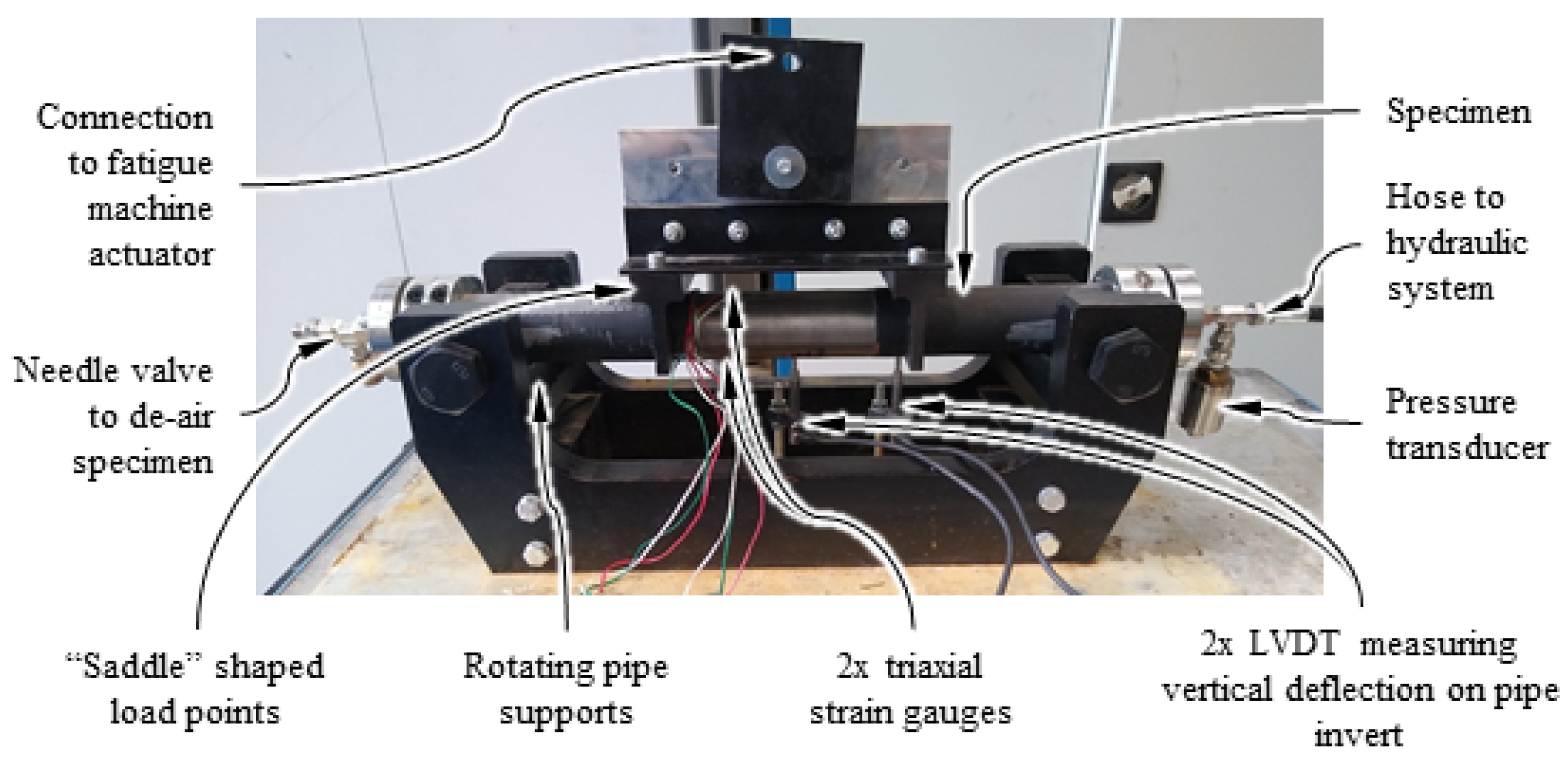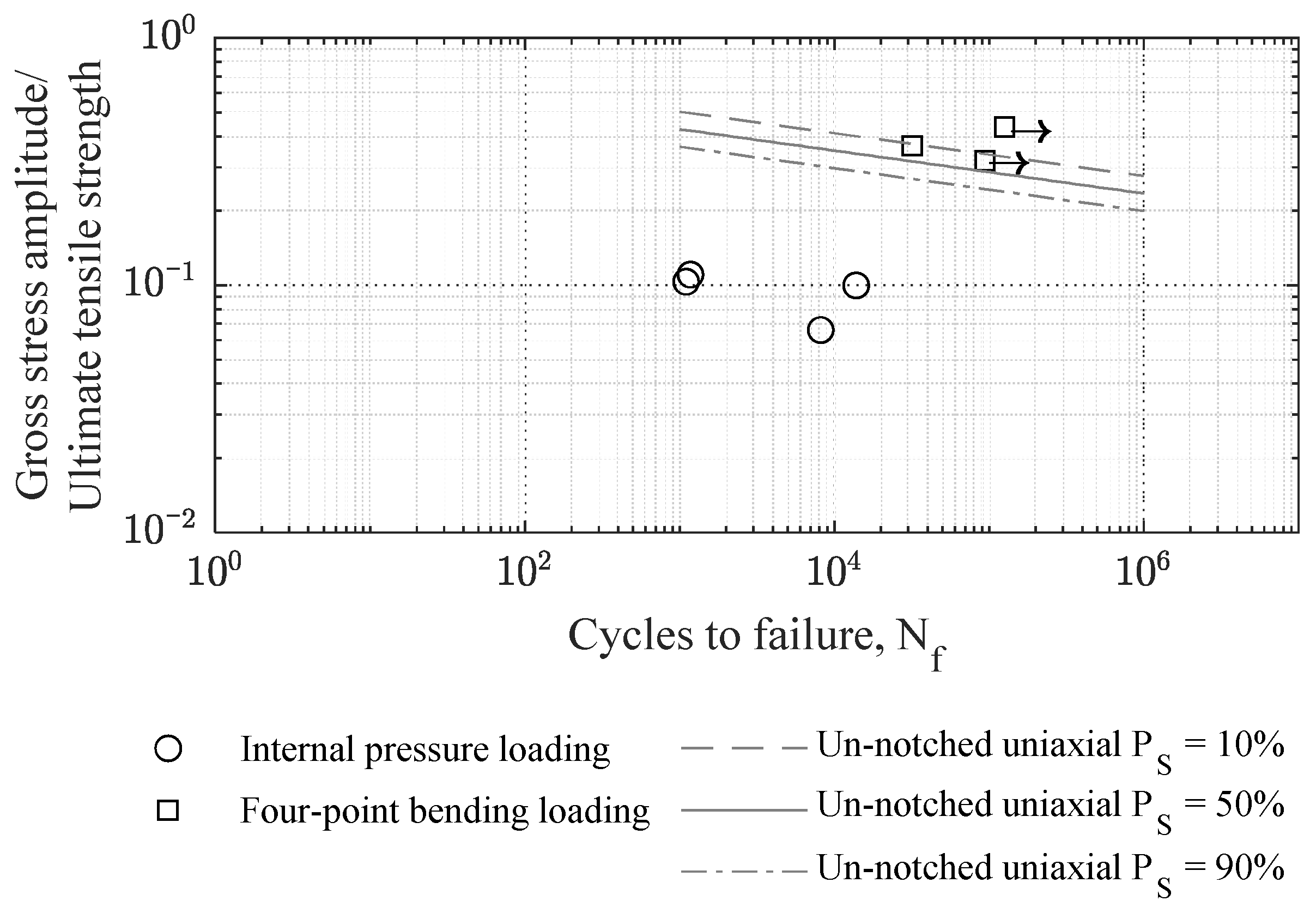Experimental Investigation of the Fatigue Strength and Leakage Failure Mode of Corroded Cast Iron Water Pipes †
Abstract
1. Introduction
2. Methods
3. Results
4. Discussion
5. Conclusions
- Pitted GCI pipes subject to internal water pressure fatigue loading can leak before they burst, and longer leakage periods appear to correlate with longer fatigue lives;
- Condition assessments of corroded GCI water pipes must consider both the three-dimensional shape of the corrosion pitting and the loading experienced by the pipe to give a true assessment of the damage caused by a corrosion pit.
Author Contributions
Funding
Institutional Review Board Statement
Informed Consent Statement
Data Availability Statement
Acknowledgments
Conflicts of Interest
References
- Sanders, J.; Marshallsay, D.; Mountfort, G.; Fox, G.; Butler, M. A Leakage Routemap to 2050; Water UK: London, UK, 2022. [Google Scholar]
- Zhang, C.; Rathnayaka, S.; Shannon, B.; Ji, J.; Kodikara, J. Numerical interpretation of pressurized corroded cast iron pipe tests. Int. J. Mech. Sci. 2017, 128–129, 116–124. [Google Scholar] [CrossRef]
- Brevis, W.; Susmel, L.; Boxall, J. Investigating in-service failures of water pipes from a multiaxial notch fatigue point of view: A conceptual study. Proc. IME C J. Mech. Eng. Sci. 2015, 229, 1240–1259. [Google Scholar] [CrossRef]
- Wang, D. Application and Evaluation of Non-Destructive Testing Methods for Buried Pipes. Master’s Thesis, Queen’s University, Kingston, ON, Canada, 2017. [Google Scholar]
- John, E.; Boxall, J.; Collins, R.; Bowman, E.; Susmel, L. Multiaxial fatigue of water pipe grey cast iron. Int. J. Fatig. 2024, 178, 108002. [Google Scholar] [CrossRef]
- Rathnayaka, S.; Shannon, B.; Jiang, R.; Kodikara, J. New laboratory test facility developed to investigate the leak-before-break window of large-diameter cast iron water pipes. J. Pipeline Syst. Eng. Pract. 2018, 9, 04018010. [Google Scholar] [CrossRef]
- Barton, N.; Farewell, T.; Hallett, S.; Acland, T. Improving pipe failure predictions: Factors effecting pipe failure in drinking water networks. Water Res. 2019, 164, 114926. [Google Scholar] [CrossRef] [PubMed]




Disclaimer/Publisher’s Note: The statements, opinions and data contained in all publications are solely those of the individual author(s) and contributor(s) and not of MDPI and/or the editor(s). MDPI and/or the editor(s) disclaim responsibility for any injury to people or property resulting from any ideas, methods, instructions or products referred to in the content. |
© 2024 by the authors. Licensee MDPI, Basel, Switzerland. This article is an open access article distributed under the terms and conditions of the Creative Commons Attribution (CC BY) license (https://creativecommons.org/licenses/by/4.0/).
Share and Cite
John, E.; Boxall, J.; Collins, R.; Bowman, E.; Susmel, L. Experimental Investigation of the Fatigue Strength and Leakage Failure Mode of Corroded Cast Iron Water Pipes. Eng. Proc. 2024, 69, 20. https://doi.org/10.3390/engproc2024069020
John E, Boxall J, Collins R, Bowman E, Susmel L. Experimental Investigation of the Fatigue Strength and Leakage Failure Mode of Corroded Cast Iron Water Pipes. Engineering Proceedings. 2024; 69(1):20. https://doi.org/10.3390/engproc2024069020
Chicago/Turabian StyleJohn, Edward, Joby Boxall, Richard Collins, Elisabeth Bowman, and Luca Susmel. 2024. "Experimental Investigation of the Fatigue Strength and Leakage Failure Mode of Corroded Cast Iron Water Pipes" Engineering Proceedings 69, no. 1: 20. https://doi.org/10.3390/engproc2024069020
APA StyleJohn, E., Boxall, J., Collins, R., Bowman, E., & Susmel, L. (2024). Experimental Investigation of the Fatigue Strength and Leakage Failure Mode of Corroded Cast Iron Water Pipes. Engineering Proceedings, 69(1), 20. https://doi.org/10.3390/engproc2024069020






